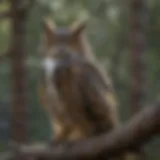Exploring the Grand Canyon: Geography and Ecology
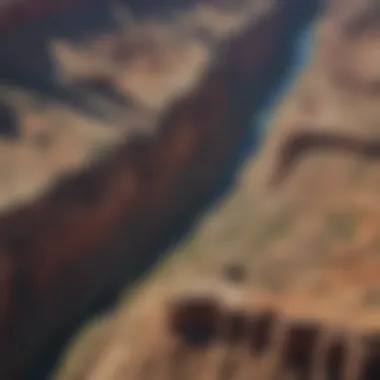

Nature Topic Overview
The Grand Canyon stands out as one of the most remarkable natural formations in the world. Located in the state of Arizona, its vast expanse stretches around 277 miles and reaches depths of over a mile. The beauty of the canyon comes not only from its size but also from the rich layers of colorful rock that tell a tale of geological history extending millions of years. This unique landscape was carved primarily by the Colorado River, a process that continues today, demonstrating the power of natural forces in shaping our Earth.
Understanding the Grand Canyon involves looking at its geography and ecology. The area is not just a visual wonder; it serves as a habitat for diverse wildlife and plant species. It supports various ecosystems, each adapted to the specific climatic and geological conditions found within the canyon. Furthermore, learning about the Grand Canyon highlights the importance of conservation in preserving such beautiful and vital natural environments for future generations.
Fun Facts and Trivia
The Grand Canyon is not only a place of stunning views but is also filled with fascinating information:
- Formation: The canyon was formed over millions of years through erosion, primarily from the Colorado River.
- Size: It is about 10 miles wide at its widest point and averages around 1 mile deep.
- Biodiversity: The Grand Canyon is home to over 1,500 plant species, 447 bird species, and numerous mammals, reptiles, and amphibians.
- Cultural Significance: The canyon has great cultural importance to several Native American tribes, including the Havasupai and Navajo.
Visiting the Grand Canyon offers a unique opportunity to see these diverse elements at play. To help visualize this, visitors can find interactive displays or ranger-led programs at the Grand Canyon National Park.
Wildlife Explorations
Within the confines of the Grand Canyon, numerous plant and animal species find their home. Some notable residents include:
Animals
- California Condor: This large bird is one of the rarest in North America, with efforts ongoing to help increase its population.
- Bighorn Sheep: Well adapted to the rugged terrain, these sheep navigate steep cliff faces with ease.
- Desert Tortoise: A slow-moving reptile that thrives in the warm desert climate.
Plants
- Ponderosa Pine: Common in higher elevations, this tree contributes to the forested areas at the rim of the canyon.
- Cacti: Various species, like the Saguaro, thrive in the desert part of the canyon.
Learning about these creatures and their habitats fosters a deeper appreciation for wildlife in the Grand Canyon. Engaging activities like wildlife identification guides can make this discovery even more fun.
Environmental Awareness
Understanding the Grand Canyon includes recognizing the importance of conservation. This iconic landmark is under threat from various environmental issues, including water usage, pollution, and climate change. To protect habitats, it is essential to:
- Reduce waste: Always recycle and dispose of trash responsibly.
- Respect wildlife: Keep a safe distance from animals and do not feed them.
- Educate others: Share knowledge about the importance of protecting the Grand Canyon with friends and family.
Children play a critical role in environmental conservation. They can start by simple actions, like participating in clean-up events or planting native plants in their backyard.
DIY Nature Activities
Exploring nature can be more hands-on. Here are some ideas for kids to try at home or outside:
- Nature Journaling: Encourage children to draw plants or animals they see. This helps them observe and appreciate their environment.
- Crafting: Collect leaves, twigs, or stones and create art inspired by the canyon.
- Exploratory Walks: Organize walks in local parks to observe similar natural features as those found in the Grand Canyon.
These activities not only enhance understanding but also strengthen a connection to nature, planting the seeds for lifelong appreciation.
The Grand Canyon serves as a reminder of nature's grandeur and our responsibility to protect it for future generations.
The Geographic Location of the Grand Canyon
The geographic placement of the Grand Canyon is crucial. It not only highlights why this area attracts millions of visitors each year but also presents several important ecological aspects. This region showcases the interplay between geological formations and ecosystems. Understanding where the Grand Canyon lies helps one comprehend its environmental significance and the richness of its biodiversity.
Where to Find the Grand Canyon
The Grand Canyon is located in the northern part of Arizona. It is situated within the Grand Canyon National Park. The national park covers over 1,900 square miles. It offers a variety of landscapes, from the canyon's deep chasms to the surrounding mountains. Two main rim areas are popular with visitors: the South Rim and the North Rim. The South Rim is more accessible and has numerous visitor facilities and scenic viewpoints. While the North Rim is less crowded and gives unique perspectives of the canyon. Overall, the area is easily reachable from major cities in Arizona like Flagstaff and Phoenix.
State and Region Overview
Arizona
Arizona is central to understanding the Grand Canyon. The state is known for its varied climate and geography. The key characteristic of Arizona is its desert landscape, which includes the iconic saguaro cactus. This distinct environment is home to numerous plant and animal species. The Grand Canyon serves as a natural haven within the Arizona deserts, offering unique ecological niches. It attracts researchers and nature enthusiasts alike. Environmental conditions in Arizona play vital roles in shaping the canyon's ecology. The advantages of exploring the Grand Canyon in Arizona include its stunning natural beauty and opportunities for outdoor activities.
Colorado River Region
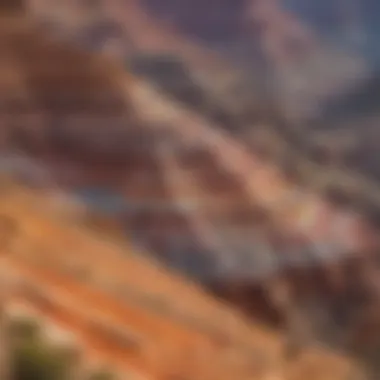

The Colorado River flows through the Grand Canyon, creating dramatic scenery and shaping its structure. The river is fundamental to the canyon’s formation. It also supports rich ecosystems along its banks. One key highlight of the Colorado River Region is the diverse wildlife it sustains. Various fish species, birds, and mammals thrive in the area. This river also provides recreational opportunities like rafting and kayaking. Many visitors appreciate experiencing the river's natural beauty. However, human activity has had effects on the river ecosystem, which needs careful management.
Surrounding National Parks
The Grand Canyon is bordered by several national parks, which enhance its ecological significance. Parks like Zion National Park and Bryce Canyon National Park contain complementing ecosystems. They showcase a variety of geological formations and biodiversity. The proximity of these parks enables deeper appreciation of natural wonders. This aspect benefits outdoor lovers and researchers. Unique features include hiking trails, stunning viewpoints, and opportunities for wildlife observation. However, increased visitor traffic can stress the natural habitats. This calls for harmonized conservation efforts between these parks and the Grand Canyon.
Understanding the geographic location of the Grand Canyon helps us appreciate the environmental balance it maintains and its rich biodiversity.
The Geology of the Grand Canyon
The Grand Canyon’s geology is not just a backdrop for stunning views; it is a window into the Earth’s history. The rock formations tell a story of millions of years, revealing the natural processes that shaped this iconic landmark. Learning about the canyon's geology helps us understand its ecosystem, its formation, and the unique features that attract visitors from around the world.
How the Canyon was Formed
The formation of the Grand Canyon is a complex process involving geological forces at play for over 70 million years. The primary driver has been the Colorado River, whose flow gradually eroded the rock, deepening and widening the canyon we see today. This erosion was enhanced by weather, including rain and freeze-thaw cycles, which further shaped the landscape.
In addition to water erosion, geological uplift has occurred. This means the land itself has risen over time, exposing deeper rock layers. As we explore the canyon, we see rock layers of different colors and compositions, each representing a chapter in the Earth’s history. Understanding this process helps readers appreciate the time scale involved in creating such a monumental feature.
Rock Layers and Composition
The Grand Canyon boasts a stunning array of rock layers, each with its own story. This variety is crucial for geologists studying Earth’s past and provides insights into past climates, ecosystems, and life forms that existed long before humans.
Visually Distinct Strata
The rock layers of the Grand Canyon are visually distinct, forming a colorful palette that is instantly recognizable. Each layer represents a different period in Earth's history. The contrasting colors reflect varied mineral compositions, which are a significant aspect of the canyon’s appeal. These distinct strata highlight how different environmental conditions contributed to the formation of the canyon.
Visually distinct strata make the Grand Canyon an exceptional place for education about geology. They facilitate easy identification of different layers for both students and researchers. However, the differences in weathering and erosion rates among these layers can lead to varying levels of stability in the canyon’s structure.
Age of Geological Layers
The age of the geological layers in the Grand Canyon spans billions of years. The oldest rocks, found at the canyon's bottom, date back to around 1.8 billion years ago. This immense age allows scientists to study significant geological events, such as how the continent drifted over millennia.
The ancient rocks hold valuable information about shifts in the Earth's crust and climate changes. Understanding the age of these layers is essential for anyone interested in geology, as it reveals the dynamic history of our planet. However, determining these ages can be technically challenging and requires specialized methods.
Erosion and Weathering Processes
Erosion and weathering are fundamental processes that have sculpted the Grand Canyon. Erosion primarily caused by water flow has carved out deep gorges, while weathering breaks down rocks into smaller particles. This continuous cycle contributes to the canyon's present shape and structure.
The effect of these processes gives us insight into the environmental changes the area has undergone. For example, weathering in the canyon enables the formation of soils necessary for flora. Understanding these processes is beneficial for conservation efforts, as they illustrate the delicate balance of the canyon’s ecosystem. It also highlights the importance of protecting the natural environment from human interference.
In summary, the geology of the Grand Canyon provides critical information about Earth's history. Its rock layers, age, and processes of erosion and weathering all contribute to its significance as a natural wonder. A deep understanding of this geology not only enriches our appreciation but also informs conservation efforts.
The Ecology of the Grand Canyon
The ecology of the Grand Canyon plays a crucial role in maintaining the health of its diverse ecosystem. It encompasses a variety of flora and fauna that interact closely within their habitats. Understanding this ecological system provides insight into the relationships between different species and their environment, emphasizing the importance of biodiversity.
Flora and Fauna
Plant Species
Plant species in the Grand Canyon are remarkable for their adaptability. The harsh climate and varying elevations create unique environments for different plant communities. For instance, species like Joshua trees and pinyon pines thrive in arid regions, while cottonwoods flourish near water sources.
These plants not only provide food and shelter for wildlife but also stabilize the soil, preventing erosion. Their deep root systems help retain moisture, enhancing the ecosystem's resilience.
Animal Species
Animal species in the Grand Canyon showcase an incredible array of life forms. Large mammals such as bighorn sheep and various predators like mountain lions inhabit the canyon's rugged terrain.
Bird species, including the California condor, are vital to the ecosystem, serving as scavengers and helping maintain ecological balance. The presence of such animals indicates a healthy ecosystem, where each plays a role in the food web.
Endemic Species
Endemic species are unique to the Grand Canyon. These species, such as the Grand Canyon rattlesnake and Kaibab squirrel, are adapted specifically to this region's environment. Their existence highlights the canyon's ecological significance. Protecting these endemic species is essential for preserving biodiversity. Their specialized needs also provide opportunities for scientific research, helping us understand ecological dynamics.
Biodiversity Importance
Habitat Conservation
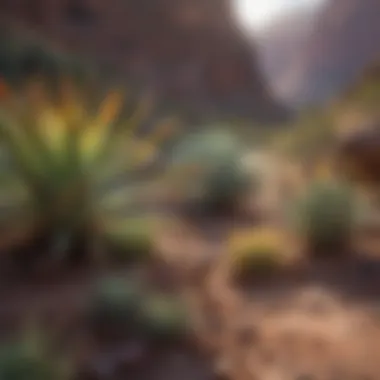

Habitat conservation is vital for sustaining the Grand Canyon's ecological landscape. With increasing human activity, the need to protect these habitats becomes even more pressing. Conservation efforts focus on balancing development with the needs of wildlife. Preserving native plant species is crucial, as they serve as the foundation for the entire ecosystem. This, in turn, maintains the natural beauty and function of the Grand Canyon.
Species Interdependence
Species interdependence within the Grand Canyon fosters a robust ecological network. Each species relies on others for survival, creating a web of interactions. For instance, predatory animals control herbivore populations, which helps maintain plant diversity. Disruption in one area can affect the entire ecosystem. Understanding these connections is essential for fostering a healthy environment.
Healthy ecosystems are often marked by a high degree of species diversity, and the Grand Canyon is no exception.
Cultural Significance of the Grand Canyon
The Grand Canyon holds immense cultural importance, particularly for the people who have lived in its vicinity for centuries. This section elaborates on the cultural richness linked to the canyon, exploring the heritage of indigenous peoples, the role of tourism, and recreational activities that define its current status in American culture.
Indigenous Peoples and Their Heritage
Historical Tribes
The Grand Canyon is home to several indigenous tribes, including the Havasupai, Hualapai, Navajo, and Hopi. These tribes have historical connections to the land that date back thousands of years. Each tribe has its own unique traditions and practices, shaping a diverse cultural landscape. The Havasupai, for example, are profoundly associated with the vibrant blue waters of Supai Falls, which is a sacred site to them.
The significance of these tribes lies not only in their historical presence but also in their enduring cultural practices. The stories and ways of life of these tribes provide insight into their relationship with the land and natural resources. It is crucial to respect and acknowledge their heritage as an essential part of the Grand Canyon’s cultural identity.
Cultural Practices
Cultural practices among these tribes are rich and varied. Traditional ceremonies, songs, and art forms are vibrant expressions of their connection to nature. Many tribes engage in seasonal rituals that coincide with the natural cycles of the canyon, emphasizing the importance of environmental stewardship and respect for the land.
The unique feature here is how these cultural practices promote sustainability. By living in harmony with their environment, these tribes showcase a model of community engagement with nature, which is beneficial not just to them but also to the preservation of the Grand Canyon. Their practices highlight the intricate bond between human beings and the land, often serving as a guide for modern conservation efforts.
Stories and Legends
The stories and legends surrounding the Grand Canyon are deeply woven into the tapestry of the tribes that inhabit the region. These narratives often serve as moral lessons, teaching respect for nature and the importance of community. Many tales feature elements of creation, spirituality, and lessons about the consequences of disrespecting the land.
These stories are not merely anecdotal; they embody communal values and identity, making them a significant element of cultural heritage. Sharing these legends adds depth to visitors’ understanding of the canyon, allowing them to appreciate its historical significance.
Tourism and Recreation
Popular Activities
Tourism at the Grand Canyon caters to a variety of interests, offering activities such as hiking, rafting, and scenic viewpoints. The Bright Angel Trail and the popular Grand Canyon Skywalk are among the most frequented spots. Popular activities encourage exploration and appreciation of the canyon's vastness and beauty.
The benefits of such activities are manifold. They enhance awareness of the canyon's ecological importance while also providing economic support to local communities through tourism. However, it is important to balance tourism with environmental care to ensure that the canyon's natural beauty remains preserved for future generations.
Impact on Local Economy
Tourism significantly contributes to the local economy, with millions of visitors flocking to the canyon each year. This influx of tourists provides job opportunities, boosts local businesses, and supports services such as lodging, dining, and guided tours.
However, the heavy reliance on tourism can be a double-edged sword. While it brings financial benefits, it can also lead to challenges like overcrowding, which may affect the natural environment. It is vital to find a sustainable approach that allows for tourism growth while ensuring the canyon's preservation.
Visitor Education Programs
Visitor education programs aim to inform tourists about the Grand Canyon's ecological and cultural significance. These programs offer guided tours, interactive exhibits, and workshops that engage visitors with the canyon's history and environment.
Such programs are essential. They help foster a sense of responsibility among visitors towards conservation and respect for indigenous cultures. Educating visitors creates awareness and encourages them to partake in preservation efforts, ensuring that the beauty of the Grand Canyon is appreciated by future generations.
In summary, the Grand Canyon is more than just a natural wonder; it is a cultural epicenter. Understanding its significance enhances the appreciation of both its beauty and the rich histories that have shaped it over time.
Conservation Efforts in the Grand Canyon
The Grand Canyon is not just a stunning view; it is also an important ecosystem with significant ecological challenges. Conservation efforts are essential to ensure that this natural wonder continues to thrive for future generations. Protecting the Grand Canyon includes various aspects such as historical initiatives, current challenges, and active management strategies. The goal is not only to preserve the natural beauty but also to maintain its ecological balance.
Historical Conservation Initiatives
Establishment of the National Park
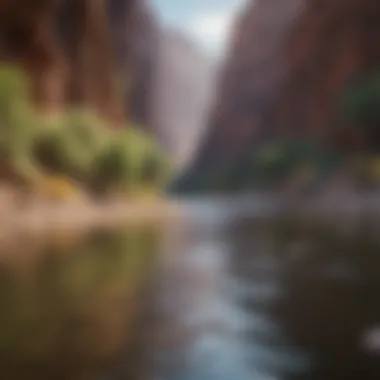

The Grand Canyon National Park was established in 1919, marking a significant effort in conservation. This initiative aimed to protect the area's remarkable geological features and biodiversity. One key characteristic of the National Park is its vastness, covering over a million acres of land. This extensive area allows a variety of habitats to flourish. Furthermore, the park attracts millions of visitors annually, which raises awareness about its natural significance. The unique feature of the Grand Canyon National Park lies in its geological history. The park showcases layers of rock that tell a story spanning millions of years. However, the benefits come with challenges as increased visitor numbers can lead to environmental strain.
Legislation for Protection
To protect the Grand Canyon, several laws and regulations have been enacted. The National Parks Service Organic Act of 1916 emphasized the need for protection of national parks for future generations. This law is crucial as it sets the standard for preserving natural environments. A significant aspect of such legislation is its legislative foundation, which allows for the management of parks like the Grand Canyon. Also, it emphasizes the preservation of both cultural and natural resources. The unique feature of these laws is that they often adapt to emerging challenges, making them effective over time. Although protective, some legislation may face opposition regarding land use and resource extraction.
Current Conservation Challenges
Climate Change Impacts
Climate change presents a pressing challenge for the Grand Canyon. Rising temperatures and changing precipitation patterns directly affect the ecosystem. One of the most critical aspects of these impacts is the potential for increased drought, altering plant and animal habitats. This issue is particularly concerning as it threatens the diversity of species within the canyon. Furthermore, the unique feature of climate change is its gradual yet profound impact, requiring immediate attention and planning to avert long-term consequences.
Pollution and Human Activity
Pollution caused by human activity also poses significant challenges for the Grand Canyon. Waste disposal and air pollution affect the quality of natural resources. A critical aspect of this challenge is the increase in litter and waste in popular tourist areas. Strict regulations and public awareness campaigns have been initiated to combat this issue. The unique feature of pollution is that it can be minimized through responsible visitor behavior. Targeted actions can lead to improved environmental conditions, which benefit all living in the ecosystem.
Invasive Species Management
The management of invasive species is another essential conservation effort. Invasive species disrupt the natural ecosystem balance and pose threats to native species. One key aspect of this challenge is identifying and addressing invasive plants and animals quickly. Many conservation programs focus on monitoring and controlling these invasives to protect native biodiversity. The unique feature of managing invasive species is the necessity for active involvement from both park management and the public. Engaging local communities helps in spreading awareness and encourages participation in conservation efforts.
Together, these conservation efforts highlight the importance of safeguarding the Grand Canyon, ensuring its beauty and biodiversity remain preserved for all to appreciate.
Visiting the Grand Canyon
Visiting the Grand Canyon is not just a recreational activity; it is an opportunity to engage with one of the most stunning natural formations in the world. It enables visitors to appreciate the beauty and complexity of the landscape as well as the ecological significance it holds. This section will discuss what to consider before visiting, including the best times to go, travel routes, transportation options, and what facilities are available for visitors. By understanding these elements, visitors can shape a more satisfying and enriching experience.
Best Times to Visit
The Grand Canyon can be visited throughout the year, but timing significantly affects the experience. Some periods are more favorable than others, primarily due to weather conditions and visitor crowds.
- Spring (March to May): This is often cited as one of the best times to visit. Weather is mild, and the flowers bloom, enhancing the Canyon's beauty.
- Summer (June to August): This is peak tourist season, which means busy trails and services. However, the warm weather is ideal for those who can handle the heat. Visitors should be prepared for intense sun and potential thunderstorms.
- Fall (September to November): Another ideal time, when temperatures lower and colors change. It offers great photo opportunities as leaves transition.
- Winter (December to February): The canyon experiences fewer visitors during winter. Some areas might be closed due to snow, but it offers a tranquil scene, and the snow-capped canyon can be quite beautiful.
Selecting the right time can enhance the visit significantly. Each season brings out different attributes of the Canyon.
Traveling to the Grand Canyon
Traveling to the Grand Canyon requires some planning. The accessibility of the Canyon from various towns and cities plays a significant role in the overall experience.
Travel Routes
The main route to reach the Grand Canyon is through the town of Tusayan, Arizona. Many visitors choose to drive, which allows for flexibility. From Williams, a small town along Route 66, visitors can take Highway 64 directly to the South Rim. Another route from Flagstaff offers scenic views along the way, making it a popular choice. These travel routes not only lead to the Canyon but also provide opportunities to see beautiful landscapes and other nearby attractions.
Advantages:
- Scenic views during the drive.
- Flexibility in travel schedule.
Disadvantages:
- Potential for traffic during peak seasons.
Transportation Options
Visitors to the Grand Canyon have multiple transportation options once they arrive. These include driving, shuttle services, and guided tours.
- Personal Vehicles: Ideal for those wishing for flexibility. Parking is available at various viewpoints.
- Shuttle Services: Operate between the visitor center and popular sightseeing spots, reducing congestion and making it easier to navigate.
- Guided Tours: Provide insights into the Canyon's history and geology, enriching the experience. They can be in large groups or private settings.
Advantages of shuttle and guided tours:
- Educational information provided.
- Reduced need for parking.
Disadvantages:
- Tours may follow strict schedules.
- Limited personal exploration time.
Visitor Facilities and Services
The Grand Canyon offers a variety of facilities for visitors. These include visitor centers, camping grounds, restrooms, and food services. The Grand Canyon Visitor Center serves as a hub for information and includes exhibits on the park's history and ecology. Hiking trails range in difficulty, catering to different skill levels. Additionally, camping is available in designated areas, allowing visitors to immerse themselves in nature. Overall, these facilities enhance visitor comfort and safety.
"The Grand Canyon is not just a destination; it's an experience that connects people to nature's marvel."






